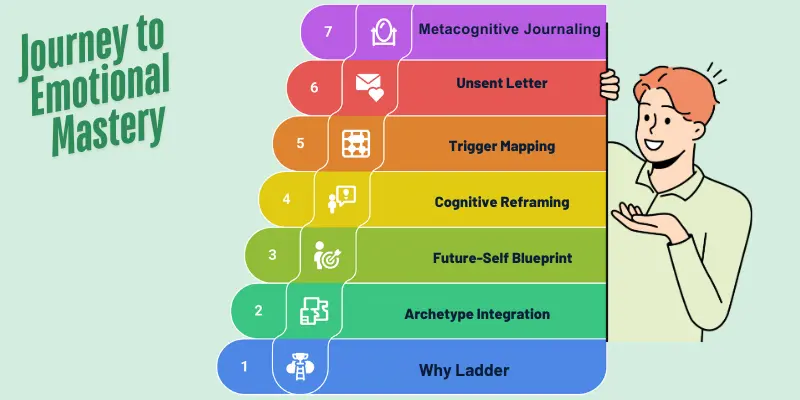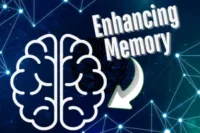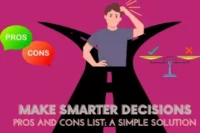Beyond the Basics: 7 Advanced Journaling Techniques for Emotional Mastery & Clarity
Published: 08/07/2025
Do you find yourself jotting down the same reflections in your journal every day, without any real breakthroughs? Are your journal pages simply a log of thoughts, rather than a launchpad for deep self-discovery? If you’re craving more than simple reflections and want to unlock the full potential of journaling, you’re not alone.
Basic journaling practices like gratitude lists and daily logs are undoubtedly valuable. They help foster awareness, promote mindfulness, and guide us through our days. However, these techniques often only scratch the surface when it comes to true emotional mastery and self-discovery. If you’ve been journaling for a while but still feel stuck, it might be time to level up.
In this guide, we’re going beyond the basics. Advanced journaling isn’t just about describing your day or jotting down a to-do list. It’s about challenging your thoughts, reframing your beliefs, and transforming your internal world. It’s about diving deep into your subconscious, questioning your patterns, and ultimately guiding yourself toward lasting emotional clarity and mastery.
If you’re ready to move beyond surface-level journaling, this guide will introduce you to 7 transformative, often overlooked, advanced journaling techniques. These techniques are specifically designed to help you navigate complex emotions, unlock subconscious patterns, and achieve profound mental and emotional clarity.
Throughout this post, we’ll explore why basic journaling isn’t enough to achieve true emotional mastery. You’ll then be introduced to powerful journaling techniques that will help you break through emotional barriers and gain clarity. By the end, you’ll have actionable methods that will turn your journaling practice into a tool for deep self-awareness and emotional growth.
Why Go “Beyond the Basics” with Your Journal?
If basic journaling has served as a useful starting point for your self-reflection, you might be wondering why you should consider stepping up your practice. The truth is, while foundational journaling methods like daily logs and gratitude lists offer initial benefits, they often fall short when it comes to achieving deeper emotional clarity and self-regulation. For those seeking to address complex emotions or make lasting changes, advanced journaling techniques provide the key to unlocking these deeper levels of understanding.

Deeper Problem-Solving
Advanced journaling techniques aren’t just about recording thoughts; they’re about actively confronting and understanding your emotions at their core. These methods give you the tools to:
- Identify the Root Causes of Emotional Triggers: Instead of simply reacting to emotional upsets, advanced journaling helps you pinpoint the underlying causes, giving you control over how you respond.
- Break Cyclical Negative Thought Patterns: We all get caught in loops of self-doubt or anxiety. Advanced journaling helps disrupt these patterns by addressing the root of the negativity and offering a space for positive transformation.
- Uncover Limiting Beliefs: What beliefs are holding you back from emotional freedom? Advanced journaling allows you to uncover and challenge these subconscious beliefs, breaking free from self-imposed barriers.
- Achieve Lasting Emotional Regulation, Not Just Temporary Relief: Basic journaling can offer short-term relief, but advanced techniques go deeper to help you regulate your emotions sustainably over time.
- Gain Profound Self-Awareness (Emotional Intelligence): Understanding your emotions goes beyond identifying them. Advanced journaling teaches you how to manage, interpret, and use emotions for your growth, thus boosting your emotional intelligence.
The Power of Intentional Inquiry
What sets advanced journaling apart is its focus on intentional inquiry. This means actively asking the right questions, guiding yourself through introspection with purpose. Unlike traditional journaling where you might simply recount events, advanced journaling encourages you to dig deeper by challenging your own assumptions, confronting uncomfortable truths, and questioning your emotional patterns.
Outperformance Strategy
While many journaling resources focus on general reflections, this guide emphasizes the psychological depth and transformative potential of advanced journaling techniques. By engaging in intentional and guided introspection, you won’t just track your emotions—you’ll understand, reframe, and transform them. This level of self-discovery and emotional mastery is the true hallmark of advanced journaling, setting this article apart from others that treat “advanced” as a superficial label.
The 7 Advanced Journaling Techniques for Emotional Mastery & Clarity
In this section, we’ll explore 7 powerful journaling techniques that go beyond the basics. These methods aren’t just about writing down your thoughts; they’re designed to help you actively transform your emotional landscape, uncover hidden patterns, and achieve deeper self-awareness. Each of these techniques provides specific outcomes that lead to emotional mastery and mental clarity.

1. The “Why Ladder” for Core Beliefs
- What It Is:
The “Why Ladder” is a journaling method that involves repeatedly asking “why” to uncover the core beliefs that are driving your emotions. By digging deeper with each question, you can identify the underlying beliefs that influence your feelings and reactions. - Why It’s Advanced:
This technique goes beyond surface-level emotional exploration. It targets limiting beliefs—the subconscious convictions that shape how we perceive ourselves and the world. By addressing these root beliefs, you can reframe your emotional responses and gain lasting emotional regulation. - How to Do It:
- Write down a current emotion or feeling you are experiencing.
- Ask yourself, “Why am I feeling this way?”
- Answer the question and then ask, “Why?” again, based on your response.
- Repeat this process 4-5 times until you uncover the core belief driving the emotion.
- Challenge the belief you uncover by writing a counter-statement or reframing it positively.
- Example Prompt/Scenario:
- “Why am I feeling frustrated?”
- “Because I feel like I’m not being heard.”
- “Why do I feel that way?”
- “Because I believe I have to prove myself to others.”
- “Why do I feel like I need to prove myself?”
- “Because I fear rejection and judgment.”
- Reframe: “I am valuable regardless of others’ opinions.”
- Expected Outcome/Benefit:
This technique will help you uncover and challenge limiting beliefs, fostering greater self-acceptance and emotional control.
2. Emotional Archetype/Shadow Integration Journaling
- What It Is:
This technique focuses on identifying and integrating hidden or disowned emotional aspects (the “shadow”) into your conscious self-awareness. By acknowledging these parts, you create a more complete, whole self. - Why It’s Advanced:
Rather than ignoring or suppressing uncomfortable emotions, this method encourages you to embrace and understand them. It fosters deep psychological growth, often revealing parts of yourself that you’ve rejected or overlooked. - How to Do It:
- Reflect on a recurring emotion or pattern you want to understand (e.g., anger, sadness, jealousy).
- Ask yourself, “What part of me is connected to this emotion?”
- Write down all the characteristics of this emotional part—how it feels, what triggers it, and how it manifests in your life.
- Explore what this part might be trying to teach you, and how you can integrate it into your life instead of rejecting it.
- Example Prompt/Scenario:
- “What does my anger want me to know about myself?”
- “Why do I feel threatened when others succeed?”
- “What part of myself am I denying by feeling this way?”
- Expected Outcome/Benefit:
This technique will help you understand unconscious emotional patterns and integrate them, leading to wholeness and emotional maturity.
3. Future-Self Emotional Blueprint
- What It Is:
The Future-Self Emotional Blueprint involves creating a vision for your ideal emotional state and mapping the journey from your current emotional challenges to your desired emotional mastery. - Why It’s Advanced:
This technique doesn’t just focus on goals; it involves emotional visualization and strategic planning, allowing you to proactively shape your emotional future. It’s about seeing beyond your present struggles to your potential growth.

- How to Do It:
- Close your eyes and visualize your ideal emotional state—how do you feel in this future version of yourself?
- Write a description of this emotional state, focusing on how you interact with challenges, people, and yourself.
- Map out the steps you would need to take to achieve this emotional state, considering any internal work or external actions.
- Example Prompt/Scenario:
- “Visualize your best self—how do you handle stress and conflict?”
- “What emotional tools do you possess in this ideal version of you?”
- Expected Outcome/Benefit:
This technique will help you create a clear emotional roadmap, giving you a sense of direction and purpose in your emotional development.
4. Cognitive Distortions Reframing (CBT Inspired)
- What It Is:
This method involves identifying and reframing negative thought patterns (cognitive distortions) that impact your emotions. It’s inspired by Cognitive Behavioral Therapy (CBT) and helps you challenge irrational beliefs. - Why It’s Advanced:
By addressing specific cognitive distortions (e.g., overgeneralization, catastrophizing), this technique goes beyond journaling and tackles the core thoughts that shape your emotional experience. - How to Do It:
- Identify a negative thought you’ve had recently (e.g., “I’m always going to fail”).
- Recognize which cognitive distortion it represents (e.g., overgeneralization).
- Challenge this thought by asking, “What’s the evidence for and against this thought?”
- Reframe the thought to be more realistic and balanced.
- Example Prompt/Scenario:
- “I failed my last project. Does this mean I’m always going to fail?”
- “What evidence do I have that proves this thought isn’t true?”
- Expected Outcome/Benefit:
This technique helps you restructure negative thoughts and achieve better emotional regulation through thought control.
5. Trigger Mapping & Response Rehearsal
- What It Is:
This technique involves identifying your emotional triggers and proactively planning healthier responses to them in advance. - Why It’s Advanced:
Moving from reactive to proactive emotional intelligence, this method helps you gain control over your emotional responses rather than being controlled by them. - How to Do It:
- Write down common situations or people that trigger emotional reactions in you.
- For each trigger, note your current automatic response (e.g., anger, defensiveness).
- Rehearse a healthier, more constructive response in writing.
- Example Prompt/Scenario:
- “When I feel criticized, I tend to shut down. How can I respond with openness instead?”
- Expected Outcome/Benefit:
This technique will help you reduce reactivity and develop better emotional control in challenging situations.
6. “Unsent Letter” for Emotional Release & Forgiveness
- What It Is:
The Unsent Letter method involves writing a letter to someone (or even a situation) you need to release or forgive. The letter is never sent, but it serves as an emotional catharsis. - Why It’s Advanced:
This technique allows you to process unresolved emotions without needing direct confrontation, leading to deeper emotional release and healing. - How to Do It:
- Write a letter to someone you need to forgive or express anger toward.
- Let the letter flow without self-censorship, saying everything you feel.
- Once finished, read the letter aloud to yourself for emotional release.
- Consider tearing it up or burning it as a symbolic act of letting go.
- Example Prompt/Scenario:
- “Write a letter to someone who has hurt you. Express everything you need to say, and forgive them in the process.”
- Expected Outcome/Benefit:
This technique facilitates emotional release and forgiveness, leading to greater emotional freedom.
7. Metacognitive Journaling (Journaling About Your Journaling)
- What It Is:
This technique involves reflecting on your journaling process itself. By examining how you think and feel while journaling, you can gain insight into your emotional blind spots. - Why It’s Advanced:
Metacognitive journaling encourages self-reflection on your thought processes, leading to deeper awareness of your unconscious biases and emotional patterns. - How to Do It:
- After journaling, take a few moments to reflect on your thoughts and feelings about the entry.
- Ask yourself, “What did I learn about my emotions during this journaling session?”
- Write about any patterns, inconsistencies, or emotional triggers you noticed in your journaling.
- Example Prompt/Scenario:
- “What insights did I gain about myself from today’s journaling session?”
- “Are there any recurring emotional themes that I need to address?”
- Expected Outcome/Benefit:
This technique will enhance self-awareness and provide clarity on your emotional landscape.
Maximizing Your Advanced Journaling Practice
While the 7 advanced journaling techniques you’ve learned are powerful tools, their true impact depends on how consistently and consciously you incorporate them into your life. Journaling is not just an activity—it’s a practice that requires patience, honesty, and an open heart. Below are a few tips for maximizing the benefits of your advanced journaling practice:

Tips for Success
- Consistency Over Perfection:
One of the most common barriers to successful journaling is the expectation of perfection. Journaling is a process, not a product. Aim for regular practice rather than perfect entries. It’s okay if some days you’re not able to complete an entire journaling session or if your thoughts are scattered. What matters is that you’re showing up and giving yourself the space to reflect. Consistency, not perfection, is key to reaping the long-term benefits of journaling. - Honesty & Non-Judgment:
To unlock the full potential of advanced journaling, you need to be completely honest with yourself. Let your writing flow without censoring your thoughts or judging yourself. This is the only way to uncover deeper emotional insights and patterns. Remember, your journal is a safe space where you can be raw and vulnerable without fear of judgment. The more open and honest you are, the more you’ll gain from the practice. - Revisit & Reflect:
Don’t let your journal entries gather dust. Re-reading your entries over time can help you recognize emotional patterns, growth, and recurring themes. Look for shifts in your emotional state, and notice if the same issues or triggers are appearing. This long-term reflection is crucial for developing a deeper understanding of your emotions and for noticing the changes that occur as a result of your journaling efforts. - Integrate with Daily Life:
Journaling doesn’t exist in a vacuum—it should have practical applications in your everyday life. The insights you gain from your journaling practice should be integrated into your actions, reactions, and decisions. For example, if you’ve uncovered a recurring emotional trigger through your journaling, try using the Trigger Mapping & Response Rehearsal technique in real-time situations. Practice applying the emotional intelligence you develop through journaling into your daily interactions to truly achieve emotional mastery. - When to Seek Professional Help:
While journaling is an incredibly powerful tool for emotional insight and self-growth, it’s important to recognize when deeper issues may require professional intervention. If you find that certain emotional challenges are overwhelming, or if journaling triggers deep trauma or unresolved mental health concerns, it’s important to seek guidance from a trained therapist or mental health professional. Journaling is a tool for growth, but it is not a replacement for professional therapy when necessary.
Expert Addition: Common Pitfalls to Avoid in Advanced Journaling
While advanced journaling can be an incredibly transformative practice, there are some common pitfalls that can hinder your progress. Being aware of these challenges is crucial for maintaining a productive and effective journaling routine. As you embark on this deeper journey of self-discovery, here are the key pitfalls to avoid:
Over-Analysis/Ruminating
It’s easy to fall into the trap of overthinking or ruminating during your journaling practice. Journaling, especially advanced techniques, can stir up deep emotions and unresolved thoughts. However, it’s important to recognize when you’ve gone from productive reflection to circular thinking that leads nowhere.
To avoid getting stuck in negative loops:
- Set time limits: Allocate a specific amount of time for journaling (e.g., 20-30 minutes). Once the time is up, step away.
- Shift focus: If you find yourself repeating the same thoughts, redirect your journaling to a different technique or prompt.
- Move to action: Journaling should lead to insight, but insight must drive action. Don’t get bogged down in analysis—use what you learn to take tangible steps forward.
Lack of Action
Journaling is a tool for self-reflection and insight, but insights alone aren’t enough. Without action, your journaling practice becomes an intellectual exercise that doesn’t bring lasting change.
To avoid stagnation:
- Use journaling to set goals: After identifying key insights or emotional patterns, create an action plan.
- Implement small changes: Take small, actionable steps based on your journaling discoveries. For example, if you’ve identified a recurring negative belief, commit to reframing it every time it arises in your thoughts.
- Reflect on progress: Review your goals and track your progress through journaling. This reinforces the idea that journaling is a tool for change, not just reflection.
Expecting Instant Results
Personal growth and emotional mastery are gradual processes. Expecting immediate results from journaling can lead to frustration or disillusionment, especially when deep-seated emotions or limiting beliefs take time to uncover and transform.
To manage expectations:
- Be patient: Understand that emotional transformation through journaling doesn’t happen overnight. It’s about the cumulative effect of consistent practice.
- Celebrate small wins: Acknowledge even the smallest shifts in your thinking and behavior. These are signs of progress and personal growth.
- Trust the process: Remember, emotional mastery takes time. Celebrate your commitment to your own emotional evolution, and trust that the work will pay off.
Fear of Discomfort
Advanced journaling often requires confronting uncomfortable emotions, challenging beliefs, and engaging with parts of yourself that you may have been avoiding. This discomfort is part of the transformative process. However, it can be intimidating, especially if you’ve been used to more surface-level reflection.
To overcome this fear:
- Ease into it: If certain techniques feel too challenging at first, start small. Build your confidence and emotional resilience gradually.
- Accept discomfort as part of the journey: Emotional growth often involves discomfort. Embrace it as a natural and necessary part of your transformation.
- Seek support if needed: If the emotional work feels too heavy, don’t hesitate to seek guidance from a therapist or support group.
Embrace Your Emotional Mastery: Your Journey Continues
From simple daily entries to profound emotional insights, you’ve now explored 7 advanced journaling techniques that will empower you to navigate your emotions with grace and clarity. These techniques are not just about reflecting on your thoughts—they’re about transforming them. By practicing these methods, you’ve taken a significant step towards achieving emotional mastery and mental clarity.
Emotional mastery isn’t a distant dream. With these advanced journaling techniques, it’s within your reach. As you continue your journey, these tools will help you uncover hidden patterns, reframe negative beliefs, and cultivate deeper self-awareness, ultimately allowing you to take full control of your emotional landscape.
Don’t just read about these techniques—take action! Choose one technique today and start your journey toward deeper self-discovery and emotional clarity. The power is in your hands to transform your inner world, one journal entry at a time.
Which advanced journaling technique resonates most with you? Share your thoughts and experiences in the comments below! Let’s start a conversation about how these techniques are shaping our emotional growth.
Ready for more? Explore our (emotional intelligence guide/journaling series) for continuous growth and self-improvement.
Advanced Journaling FAQs: Unlocking Deeper Emotional Mastery & Clarity
Advanced journaling techniques go beyond simple reflection. They involve deep introspection, challenging beliefs, and transforming emotions, rather than just recording daily events or thoughts.
Yes! By using advanced journaling techniques, you can identify emotional triggers, break negative thought patterns, and foster emotional regulation, leading to greater emotional mastery over time.
The “Why Ladder” helps uncover the root beliefs behind your emotions by asking “why” repeatedly. This technique helps identify limiting beliefs that influence your reactions, enabling you to challenge and reframe them.
Start small and set a consistent time each day, even if it’s just 10-15 minutes. Incorporate journaling into your daily schedule as a ritual, whether it’s in the morning or before bed.
Absolutely! Techniques like the “Why Ladder” can help you understand the root of your self-doubt and challenge the beliefs that feed it, leading to more positive self-empowerment.
Journaling can be a valuable tool for self-reflection, but it should not replace professional therapy for deeper emotional issues or trauma. Always seek a therapist’s guidance if needed.
Make journaling part of your daily routine, even if it’s just for a few minutes. Consider journaling as a tool for clarity and stress relief that helps you navigate busy days more effectively.
No special journal is needed! Use whatever medium feels comfortable—whether it’s a physical notebook, a digital app, or an online platform. What matters most is your commitment to the practice.
Start by focusing on intentionality. Each journaling session should have a clear purpose, whether it’s emotional release, self-discovery, or pattern recognition. If you’re actively challenging and reflecting on your emotions, you’re on the right track.

- Be Respectful
- Stay Relevant
- Stay Positive
- True Feedback
- Encourage Discussion
- Avoid Spamming
- No Fake News
- Don't Copy-Paste
- No Personal Attacks



- Be Respectful
- Stay Relevant
- Stay Positive
- True Feedback
- Encourage Discussion
- Avoid Spamming
- No Fake News
- Don't Copy-Paste
- No Personal Attacks




